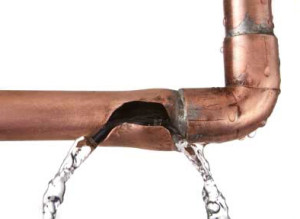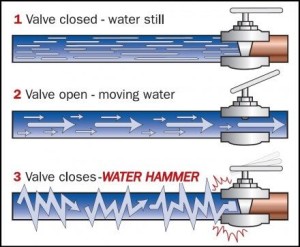Tech Talk: Water Hammer & Pulsation
The Effects of Water Hammer & Pulsation
 Quick closing valves, positive displacement pumps, and vertical pipe runs can create damaging pressure spikes, leading to blown diaphragms, seals and gaskets, not to mention also destroying meters and gauges.
Quick closing valves, positive displacement pumps, and vertical pipe runs can create damaging pressure spikes, leading to blown diaphragms, seals and gaskets, not to mention also destroying meters and gauges.
Liquid, for all practical purposes, is not compressible and any energy that is applied to it is instantly transmitted. This energy becomes dynamic in nature when a force, such as quick closing valve or pump, applies velocity to the fluid.
Surge (Water Hammer)
Surge or water hammer, as it is commonly known, is the result of a sudden change in liquid velocity. Water hammer usually occurs when a transfer system is quickly started, stopped or is forced to make a rapid change in direction. Any of these events can lead to catastrophic system component failure. Without question, the primary cause of water hammer in process applications is the quick closing valve, whether manual or automatic. A valve closing in 1.5 sec. or less, depending upon valve size and system conditions, causes an abrupt stoppage of flow. The pressure spike (acoustic wave) created at rapid valve closure can be high as five (5) times the system working pressure.
Unrestricted, this pressure spike or wave will rapidly accelerate to the speed of sound in liquid, which can exceed 4000 ft/sec. It is possible to estimate the pressure increase by the following formula.
Water Hammer Formula: P = (0.070)(V)(L)/t+P1
Where P = Increase in pressure
P1 = Inlet Pressure
V = Flow velocity in ft/sec
t = Time in sec.(Valve closing time)
L = Upstream Pipe Length in feet
Here’s an example of pressure hammer when closing a Plastomatic EASMT solenoid valve, with a 50 ft long upstream pipe connection:
L = 50 ft
V = 5.0 ft/sec (recommended velocity for PVC piping design)
t = 40 ms(solenoid valve closing time is approx. 40-50 ms)
P1 = 50 psi inlet pressure
therefore, P = 0.07 x 5 x 50 / 0.040 + P1, or P = 437.5 psi + P1
Total Pressure = 437.5 + 50 = 487.5 psi
Pulsation
Pulsation generally occurs when a liquid’s motive force is generated by reciprocating or peristaltic positive displacement pumps. It is most commonly caused by the acceleration and deceleration of the pumped fluid. This uncontrolled energy appears as pressure spikes. Vibration is the visible example of pulsation and is the culprit that usually leads the way to component failure.
Unlike centrifugal pumps (which produce normally non-damaging high-frequency but low-amplitude pulses), the amplitude is the problem because it’s the pressure spike. The peak, instantaneous pressure required to accelerate the liquid in the pipe line can be up to ten (10) times greater than the steady state flow pressure produced by a centrifugal pump. Damage to seals, gauges, diaphragms, valves and joints in piping result from the pressure spikes created by the pulsating flow.
Remedy
We suggest that you install a pulsation dampener. Dampeners provide the most cost efficient and effective choice to prevent the damaging effects of pulsation. A surge suppressor is in design essentially the same as pulsation dampener. The difference primarily lies in sizing and pressurizing.
The most current pulsation dampener design is the hydro-pneumatic dampener, consisting of a pressure vessel containing a compressed gas, generally air or Nitrogen separated from the process liquid by a bladder or diaphragm. The dampener is installed as close as possible to the pump or quick closing valve and is charged to 85% of the liquid line pressure. Proper sizing of the pulsation or surge suppressor requires several calculations. A close contact with the suppressor’s manufacturer will ensure the correct sizing for a particular application.
Conclusion
By knowing how to effectively use pulsation dampeners to avoid situations that will create water hammer or pulsations during the specification process, or while trouble shooting, you can eliminate many problems, failed valves and equipment, and costly downtime.
Contact Ryan Herco Flow Solutions today to speak with our Customer Service Representatives or our Tech Team about how a pulsation dampener can help your critical flow applications.
Article courtesy of Yahya Bengali & Rick Bolger, Plast-O-Matic Valves, Inc.